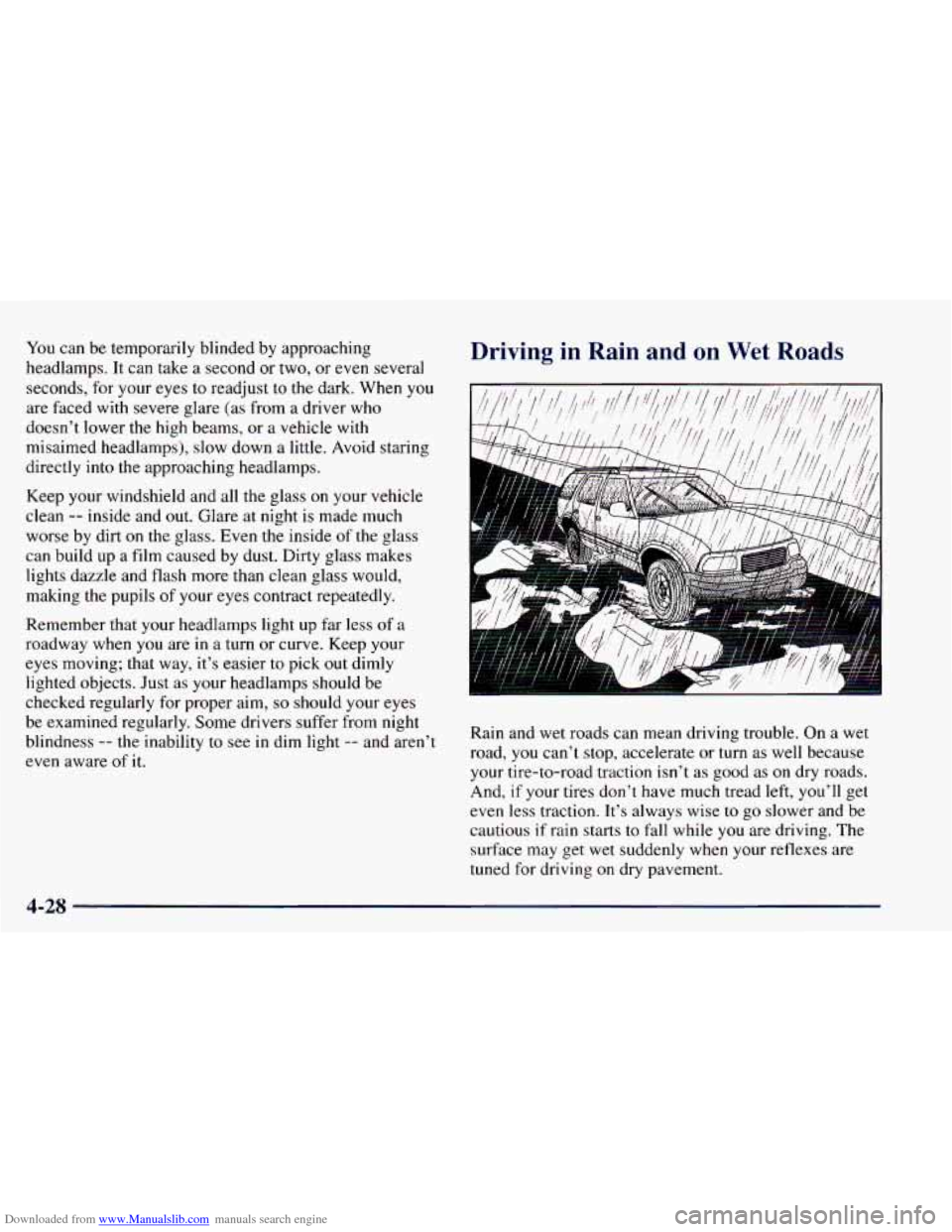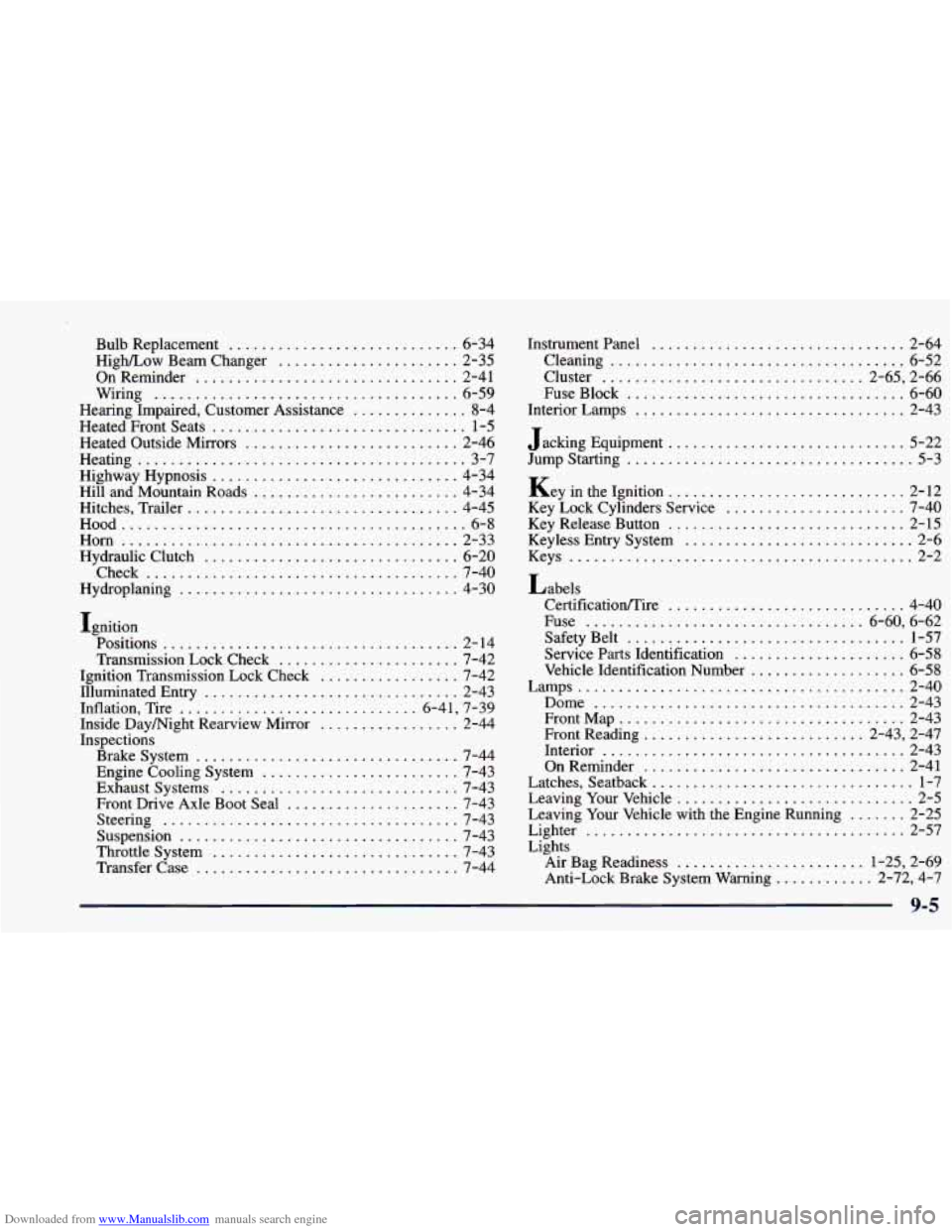1998 CHEVROLET BLAZER low beam
[x] Cancel search: low beamPage 108 of 416

Downloaded from www.Manualslib.com manuals search engine Turn SignaVMultifunction Lever
LL
Turn and Lane Change Signals
The turn signal has two upward (for right) and two
downward (for left) positions. These positions allow you
to signal a turn or a lane change.
To signal a turn, move the lever all the way up or
down. When the
turn is finished, the lever will
return automatically.
An arrow on the instrument
panel will flash in the
direction of the turn or
lane change.
The lever on the left side
of the steering column
includes your:
Turn Signal and Lane Change Indicator
Headlamp High/Low Beam Changer
Windshield Wipers
Windshield Washer
Cruise Control (If Equipped) To
signal a lane change, just raise or lower the lever
until the arrow starts to flash. Hold
it there until you
complete your lane change. The lever will return
by
itself when you release it.
As you signal a turn or a lane change, if the arrows don’t
flash but just stay on, a signal bulb may be burned out
and other drivers won’t see your
turn signal.
2-34
Page 109 of 416

Downloaded from www.Manualslib.com manuals search engine If a bulb is burned out, replace it to help avoid an
accident. If the arrows don’t
go on at all when you
signal a turn, check the fuse (see “Fuses and Circuit
Breakers” in the Index) and for burned-out bulbs.
If
you have a trailer towing option with added wiring for
the trailer lamps, a different turn signal flasher is used.
With this flasher installed, the signal indicator will flash
even
if a turn signal bulb is burned out. Check the front
and rear turn signal lamps regularly to make sure they
are working.
-7 Signal On Chime
lr your turn signal is left on ror more than 3/4 of a mile
(1.2 km), a chime will sound at each flash of the turn
signal.
To turn off the chime, move the turn signal lever
to the off position.
Headlamp High/Low Beam Changer
To change the headlamps from low beam to high or high
to low, pull the multifunction lever all the way toward
you. Then release it.
When the high beams are on, this indicator light on
the instrument panel will
also be on.
2-35
Page 116 of 416

Downloaded from www.Manualslib.com manuals search engine Daytime Running Lamps
Daytime Running Lamps (DIU) can make it easier for
others to see the front
of your vehicle during the day.
DRL can be helpful in many different driving
conditions, but they can be especially helpful in the
short periods after dawn and before sunset.
The DRL system will make your headlamps come
on at
reduced brightness when:
0 the ignition is on,
the headlamp switch is in automatic headlamp
mode and
the parking brake is released.
When the DRL are on, only your headlamps will be on.
The taillamps, sidemarker and other lamps won’t be
on.
The instrument panel won’t be lit up either.
When it begins to get dark, the headlamps will
automatically switch from DRL to the regular headlamps.
When
you turn the headlamp switch off, the regular lamps
will
go off, and your headlamps will change to the reduced
brightness of DRL provided it is not dark outside.
To idle your vehicle with the DRL off, set the parking
brake.
The DRL will stay off until you release the
parking brake.
As with any vehicle, you should turn on the regular
headlamp system when
you need it.
Fog Lamps (If Equipped)
Use your fog lamps for better vision in foggy or misty
conditions. Your parking lamps must be
on for your fog
lamps to work.
The fog lamp switch is on the instrument panel under
the lamps switch. Press the switch
to turn the fog lamps
on. Press the switch again to turn them off.
A light will
glow in the switch when the fog lamps are
on.
Remember, fog lamps alone will not give off as much
light as your headlamps. Never use your fog lamps in
the dark without turning
on your headlamps.
Fog lamps will go off whenever your high-beam
headlamps come on. When the high beams go off, the
fog lamps will come on again.
2-42
Page 210 of 416

Downloaded from www.Manualslib.com manuals search engine You can be temporarily blinded by approaching
headlamps. It can take a second or
two, or even several
seconds, for your eyes to readjust to
the dark. When you
are faced with severe glare (as from a driver who
doesn’t lower the high beams, or a vehicle with
misaimed headlamps), slow down a little. Avoid staring
directly into the approaching headlamps.
Keep your windshield and all the glass on your vehicle
clean
-- inside and out. Glare at night is made much
worse
by dirt on the glass. Even the inside of the glass
can build up a film caused by dust. Dirty glass makes
lights dazzle and flash more than clean glass would,
making the pupils of your eyes contract repeatedly.
Remember that your headlamps light up far less of a
roadway when
you are in a turn or curve. Keep your
eyes moving; that way,
it’s easier to pick out dimly
lighted objects. Just as your headlamps should be
checked regularly for proper aim,
so should your eyes
be examined regularly. Some drivers suffer from night
blindness
-- the inability to see in dim light -- and aren’t
even aware of it.
1 -I and on Wet Roads
Rain and wet roads can mean driving trouble. On a wet
road,
you can’t stop, accelerate or turn as well because
your tire-to-road traction isn’t as
good as on dry roads.
And,
if your tires don’t have much tread left, you’ll get
even less traction. It’s always wise to go slower and be
cautious
if rain starts to fall while you are driving. The
surface may get wet suddenly when your reflexes are
tuned for driving
on dry pavement.
4-28
Page 334 of 416

Downloaded from www.Manualslib.com manuals search engine Replacement Bulbs
Lamps
Halogen Headlamps, Composite Low Beam
Halogen Headlamps, Composite High Beam
Tail and Stop Lamps
Front Sidemarker Lamps
Front Turn Signal Lamps
Turn Signal Lamps
Quantity
2
2
4
2
2
2
Capacities and Specifications
Engine Description ............ “VORTEC” 4300
Type
.................................... V6
VINCode
.................................W
Firing Order ...................... 1-6-5-4-3-2
Horsepower
................... 190 at 4,400 rpm
Thermostat Specification ........... 195 OF (9 1 “C)
Spark Plug Gap
.......... 0.045 inches (0.1 14 cm)
Number
9006 HB4
9005 HB3
3057
194 NA
3157
3157 NA
Wheels and Tires
Wheel Nut Torque ........... 1001b-ft (140 N-m)
Tire Pressure
...... See the CertificatiodTire label.
See “Loading
Your Vehicle” in the Index.
6-64
Page 405 of 416

Downloaded from www.Manualslib.com manuals search engine Bulb Replacement ............................ 6-34
OnReminder
................................ 2-41
Wiring
..................................... 6-59
Hearing Impaired. Customer Assistance
.............. 8-4
Heated Front Seats
............................... 1-5
Heated Outside Mirrors
.......................... 2-46
Heating
........................................ 3-7
Highway Hypnosis
.............................. 4-34
Hill and Mountain Roads
......................... 4-34
Hitches. Trailer
................................. 4-45
Hood
.......................................... 6-8
Horn
......................................... 2-33
Hydraulic Clutch
............................... 6-20
Check
...................................... 7-40
Hydroplaning
.................................. 4-30
HighLow
Beam Changer
...................... 2-35
Ignition Positions
.................................... 2-14
Transmission Lock Check
...................... 7-42
Illuminated Entry
............................... 2-43
Inflation. Tire
............................. 6.41. 7.39
Inside Daymight Rearview Mirror
................. 2-44
Inspections Brakesystem
................................ 7-44
Engine Cooling System
........................ 7-43
Exhaust Systems
............................. 7-43
Front Drive Axle Boot Seal
..................... 7-43
Steering
.................................... 7-43
Suspension
.................................. 7-43
Throttle System
.............................. 7-43
Transfer Case
................................ 7-44
Ignition Transmission Lock Check
................. 7-42 Instrument Panel
............................... 2-64
Cleaning
.................................... 6-52
Cluster
................................ 2.65. 2.66
Fuse Block
.................................. 6-60
Interior Lamps
................................. 2-43
Jacking Equipment
............................. 5-22
Jump Starting
................................... 5-3
Key in the Ignition
............................. 2-12
Key Lock Cylinders Service
...................... 7-40
Key Release Button
............................. 2-15
Keyless Entry System
............................ 2-6
Labels Keys
.......................................... 2-2
Certificatioflire
............................. 4-40
Fuse
.................................. 6.60. 6.62
Safety Belt
.................................. 1-57
Service Parts Identification ..................... 6-58
Vehicle Identification Number
................... 6-58
Lamps
........................................ 2-40
Dome
...................................... 2-43
FrontMap
................................... 2-43
Front Reading
........................... 2.43. 2.47
Interior
..................................... 2-43
OnReminder
................................ 2-41
Latches. Seatback
................................ 1-7
Leaving Your Vehicle
............................. 2-5
Leaving Your Vehicle
with the Engine Running ....... 2-25
Lighter
....................................... 2-57
Lights Air Bag Readiness
....................... 1.25. 2.69
Anti-Lock Brake System Warning ............ 2.72. 4.7